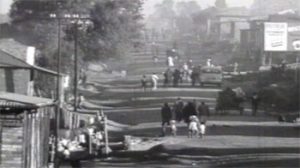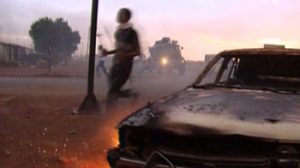Historical Background: From Apartheid to Democracy in South Africa
Importance of South Africa’s Transition to Democracy
It is common for leaders of post-conflict governments to claim an attachment to democracy. While the meaning of democracy varies, its desirability (whatever “it” is) is embraced. South Africa has a special place on the list of countries claiming this aspiration. Its struggle against an oppressive regime attracted high levels of international attention, as did its seemingly miraculous peaceful transition in 1994. Rather than the bullets and blood feared by the world’s onlookers, ballots cast through universal suffrage in a free and fair election brought forth the New Democracy. South Africa is an exemplar—its success or failure has significance far beyond its borders. That South Africa is also the economic engine for the entire African continent adds to the importance of its success.
Relevant History: Apartheid and the Anti-Apartheid Struggle
An appreciation of Courting Justice is enhanced by an understanding of South Africa’s pre-1994 history, of the struggle which led to the 1994 election and of the human rights-based constitutional democracy promising a future in sharp contrast to the apartheid past.
Apartheid
Two post-apartheid Constitutional Court Justices captured pre-1994 South Africa. “Our past,” they stated, “is not merely one of repressive use of state power. It is one of persistent, institutionalized subjugation and exploitation of a voiceless and largely defenceless [sic] majority by a determined and privileged minority…. The past was pervaded by inequality, authoritarianism and repression.”
Apartheid’s roots were firmly implanted in a racist and oppressive past that spanned three and a half centuries. The first white settlers, the Dutch ancestors of the Afrikaners, came to South Africa in 1652. They viewed the Africans with condescension. They imposed racial segregation that over the following decades developed into disenfranchisement of blacks, removal of land rights to all but a miniscule percent of African farmers, forced removals and confinement to native reserves. These actions secured land ownership for whites and destroyed the native agricultural economy—creating an unanchored labor force available then to work in the diamond and gold mines. During World War II, when the white economy flourished and demanded more labor, the ruling National Party—the governing party throughout the apartheid years, enacted legislation intended to destroy what remained of the rural black economy.
Following the war, hailed by the allies as a fight to save democracy, the National Party government added brutal political suppression to its policies of segregation and economic confinement. Control of the mission schools, whose graduates were an important component of the country’s black intellectuals and black political elite, was shifted from church to state. These schools were then integrated into the separate black Bantu system intended, according to apartheid’s architect, H.F. Verwoerd, to teach blacks “that equality with Europeans is not for them.”
Subsequent actions pressed down harder:
- Banning the Communist Party and “kindred” organizations, which the state decided included the African National Congress [ANC] and the Pan Africanist Congress
- Banning members of these organizations from any political or social activity. Most banning orders restricted the individual to contact with only one person at any time
- Denying Coloureds (that is, those of mixed race) the right to vote
- Forcing the relocation of thousands from rural homelands. (In 1955, to cite one instance, 58,000 people were relocated by force from Sophiatown to Soweto near Johannesburg).
- Requiring women, as well as men, to carry a passbook—a document authorizing them to be where they were
- Declaring a nationwide state of emergency that allowed arrests and detention (i.e., holding those detained in police cells, often to be tortured) for what in practice was an unlimited number of days without trial and
- Extending the government’s terrorism into other countries
An example of the effect of these actions is seen in the oppression of Duma Nokwe, the Secretary General of the ANC and the only black lawyer who could appear before Johannesburg courts. He was not allowed chambers in court (“chambers” is the office of litigating attorneys) nor allowed to own property. Under apartheid, he was, like all blacks, a “temporary sojourner.” These actions affected thousands—in 1960, 2,000 political activists were detained, and one in ten African adults was convicted in the cities for pass law violations. The numbers mounted as the years passed.
South Africa’s Action Seen ‘round the World
The anti-apartheid struggle attracted significant global attention and support, in part because the South African government’s actions were shown to be brutal, sadistic, oppressive and flagrant violations of the rule of law. They were seen to be unjust in the extreme. Among the actions which attracted global notice were the:
1956-1961 Treason trial
In December 1956, the government, hoping to use its security laws to suppress the opposition movement, arrested 156 apartheid opponents, charging them with high treason. Although the trial continued for five years, the court failed to convict any of those charged.
March 21, 1960 Sharpeville Massacre
The police attacked a peaceful gathering in Sharpeville—most assembled there had come to hear an expected announcement about the pass laws. At least sixty-nine died (most from having been shot in the back) and many more were wounded. The incident sparked world-wide condemnation.
1963- 64 Rivonia Trial
The South African government charged ten anti-apartheid leaders, including Nelson Mandela, with sabotage and planning for guerilla warfare. Eight were given life sentences. Thus began Mandela’s twenty-seven years of imprisonment.
1974- Cross border actions
Beginning in February 1974 the South African government reached beyond its borders with car bombs, letter bombs and raids to assassinate anti-apartheid fighters who had mobilized in other African countries.
June 16, 1976-1977 Soweto Uprising
A national rebellion, led by students, was triggered on June 16, 1976 when police fired on school children who had gathered to protest a new rule requiring that some subjects be taught in Afrikaans, the language of the ruling white minority. Over the following year, at least 700 protesters died and several thousand were held in prison for lengthy periods—the vast majority were children, many as young as seven. The government banned additional organizations and newspapers. The Soweto uprising and the government’s responses fueled a growing movement to boycott South African products.
September 1977Torture and Murder of Steve Biko
Steve Biko, the founder of the black consciousness movement, was taken into custody, beaten severely in the Security Police cells, and left to die. In South Africa, Biko became ”a tragic martyr to the cause of his people’s emancipation.” Biko’s death ultimately led to a United Nations arms embargo against South Africa.
1986 State of Emergency
The South African government declared a state of emergency and intensified its repression, detention (i.e. holding in prison cells for what in practice was an unlimited number of days) and torturing thousands.


Two Independent Changes Significant to the Anti-Apartheid Movement
By 1955, the independence movement throughout Africa was gathering momentum. This connected the anti-apartheid struggle in perception and in substance to a continent–wide fight for freedom. Ghana’s independence in 1957 meant, to use Thabo Mbeki’s characterization, that “the African giant was awakening. We knew then that the promise we had inherited would be honoured.”
The second significant change was the cold war thaw, beginning in 1986. The United States and its allies could be freed from determining their actions toward African countries on the basis of their effect on Soviet power. The end of the cold war also enhanced the effectiveness of United States civil rights and human rights activists in winning support for the anti-apartheid movement.
The Struggle
The anti-apartheid movement in South Africa involved a number of organizations. They differed in philosophy, aims and strategies. Like other organizations, the ANC worked underground and in exile, mounted protest demonstrations, used firearms, and engaged in sabotage. But, at the end of the struggle, it was the ANC that occupied the lead role among the anti-apartheid organizations.
Many ANC efforts contributed to its achieving this status. Important among which were:
- its vision of a human rights-based constitutional democracy—a vision which had been articulated in 1955 and maintained as a statement of purpose throughout the following decades
- its international diplomacy
- its behind-the-scenes meetings with white South Africans
Vision of a Human Rights-Based Constitutional Democracy
In June 1955, the ANC convened a multiracial Congress of the People, attended by almost 3,000 delegates. The Congress produced the Freedom Charter, a manifesto for equality. The Freedom Charter provided a strong moral motivation and substantive understanding for ANC’s liberation activities over the subsequent decades. For example, it was the policy of the ANC government in exile not to torture its prisoners.
International Diplomacy
One of ANC’s major goals was to establish itself as the legitimate representative of black South Africans and the legitimate government in exile.
The ANC initiated this strategy in the 1960s. In 1971, it established Lusaka, the capital of Zambia, as headquarters for its government in exile. It had also established offices in London and elsewhere. By 1982, in Lusaka alone, it housed a staff of 9,000 and it ran twenty-one diplomatic missions.
The ANC’s purpose in gaining international support was to pressure the South African government to negotiate a peace. The end goal, as Thabo Mbeki stated in an interview, was not to overthrow the government. The goal was to “turn… so many people against it that it will be forced to negotiate.”
ANC diplomats were persistent and skillful in lobbying to develop international support. They succeeded in gaining support for an embargo on South Africa, for the perception that the South African government policy was built on gross human rights violations, for the release of Nelson Mandela—who had become the symbol of the anti-apartheid cause, and for a negotiated peace.
In the United States, the ANC succeeded in mobilizing widespread support. Important among its supporters was an African-American lobby. For many, the anti-apartheid struggle became a successor to the United States’ civil rights movement. Thabo Mbeki, who led ANC’s diplomatic effort and who later served as South Africa’s Deputy President and then President, met with heads of U.S. corporations, foundation presidents, and newspaper editors. An indication of the success of these efforts was the congressional enactment late in 1986 of the Comprehensive Anti-Apartheid Act—with sufficient support to override President Reagan’s veto. As noted by South African journalist Mark Gevisser, the U.S. anti-apartheid law was “the toughest ever imposed on South Africa and would play a definitive role in forcing the South African government to the table.” Later, the United States extended an official invitation to the ANC diplomats. The invitation and their meeting with the Secretary of State were seen as a recognition that the anti-apartheid struggle was a liberation movement—rather than a terrorist operation, and that the ANC was the organization offering a democratic alternative.
Support was, of course, not confined to the United States. It was global. One indication of this was the action taken by the United Nations. In 1977, the U.N. convened a Conference Against Apartheid, the aim of which was an arms embargo. The arms embargo was ratified a few months later by the UN General Assembly. The Commonwealth countries, to which South Africa had once belonged, appointed an Eminent Persons Group to encourage negotiations.
Engaging White South Africans
The ANC strategy of “turning people against the government” included engaging white South Africans. There were secret meetings between white South Africans and ANC leaders. One series of such meetings is the subject of Endgame, a PBS Masterpiece dramatization of face-to–face meetings between ANC representatives and Afrikaners. These meetings were arranged by a British businessman with mining interests in South Africa.
The meetings featured in Endgame were preceded by others. Thabo Mbeki had frequent meetings with white South Africans. In September 1985 a delegation of seven white South African businessmen went to Lusaka to meet with ANC leaders; and later that year, Frederick Van Zyl Slabbert, the leader of parliament’s liberal opposition party, led a group of parliament members to meet ANC leaders in Lusaka. Six months later, Slabbert—who was responsible for initiating what became a number of conversations between Mbeki and the chairman of a secret society dedicated to Afrikaan nationalism, formed the Institute for a Democratic Alternative for South Africa [IDASA]. IDASA played an important role during the final years of the struggle in bringing white leaders and ANC exiles together.
The End in Sight
By 1985, there were some within the ruling National Party who had moved toward the possibility of a negotiated settlement. In September 1989 ANC leaders and South African government representatives met in Lucerne, Switzerland; two weeks later the government reduced restrictions on political organizations and released—with the exception of Nelson Mandela— those found guilty at the Rivonia trials.
On February 2, 1990 President FW de Klerk announced Mandela’s release and the end of the ban against political organizations and individuals. Six days later South Africa’s Foreign Minister, Pik Botha, and Thabo Mbeki appeared on ABC’s special Nightline edition, broadcast by satellite. Botha praised the ANC leader for his “reasonable attitude,” and acknowledged that a “mistake” had been made “years ago” in not talking to ANC leaders. He referred to Mbeki and Chief Mangosuthu Buthelezi, Zulu leader of the Inkatha Freedom Party who was also present, as “my black brothers.” ABC’s Ted Koppel asked Mbeki, labeled by the apartheid government as a terrorist, how it felt now to be called brother. ”We are all of us, black and white, brothers and sisters. And if we see ourselves as South Africans, with one nationhood and one destiny, I think a solution then becomes possible.”
On February 11, 1990 Nelson Mandela was released.
Toward the New Democracy
These celebrated moments did not reflect the country’s reality of political instability and violence. Substantial differences among the freedom fighting organizations and between the ANC and the Inkatha Freedom Party; among the pro-apartheid factions; and between those who had been on opposite sides in the struggle presented major obstacles to moving forward.
The differences were expressed in nation building negotiations—but some were also expressed in mass actions, strikes and politically motivated violence. One historian characterized it as “open season for black as well as white extremists. On both sides there was considerable loss of life.” Political violence during 1994 resulted in three times as many deaths as had occurred during the Soweto uprising of 1976-1977. In this unstable context “ordinary” crimes of murders, rapes, robberies and white collar thefts also increased.
The work that needed to be done in order to establish a human rights-based constitutional democracy should have been daunting. There were the immediate challenges, such as assuring the safe return of exiles, releasing all political prisoners, repealing police-state laws, and disarming those who had fought on both sides of the struggle. On top of these challenges were the enormous challenges to be met in creating a human rights-based constitutional democracy—the very opposite of apartheid. The challenges here included crafting an interim government—the Government of National Unity; drafting an interim constitution; writing the “final” constitution; and holding the first non-racial parliamentary elections. Looking at what needed to be done in order to hold that election provides a numerical clue as to the obstacles that had to be scaled. The newly created and thus inexperienced Independent Election Commission had to employ and train 300,000 workers, establish 9,000 voting and 900 ballot counting stations, design and print ballots that included names, pictures and logos for parliamentary candidates representing nineteen political parties and those representing the twenty-four parties putting forth candidates for provincial bodies.
Despite the pulls toward failure, the state-building challenges were met. A non-racial general election was held April 26-28, 1994. Soon after, Nelson Mandela was inaugurated as President, and Thabo Mbeki and F.W. de Klerk were inaugurated as Deputy Presidents of an interim government—the Government of National Unity. On December 4, 1996, after six and a half years of negotiations following President de Klerk’s announcement of Mandela’s release, the constitution was certified by the newly established Constitutional Court. As expressed by two Constitutional Court Justices, nowhere else had enemies agreed on the process that effected the “leap from minority rule to representative democracy….” What had been accomplished was noted around the world and recognized as the extraordinary feat of reconciliation that it was. It was, as is printed large on the gateway wall to Robben Island—i.e., Mandela’s “home” for most of his 27 years of imprisonment.
A TRIUMPH OF THE HUMAN SPIRIT AGAINST THE FORCES OF EVIL;
A TRIUMPH OF WISDOM AND LARGENESS OF SPIRIT AGAINST SMALL MINDS AND PETTINESS;
A TRIUMPH OF COURAGE AND DETERMINATION OVER HUMAN FRAILTY AND WEAKNESS.
